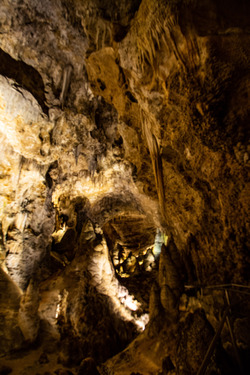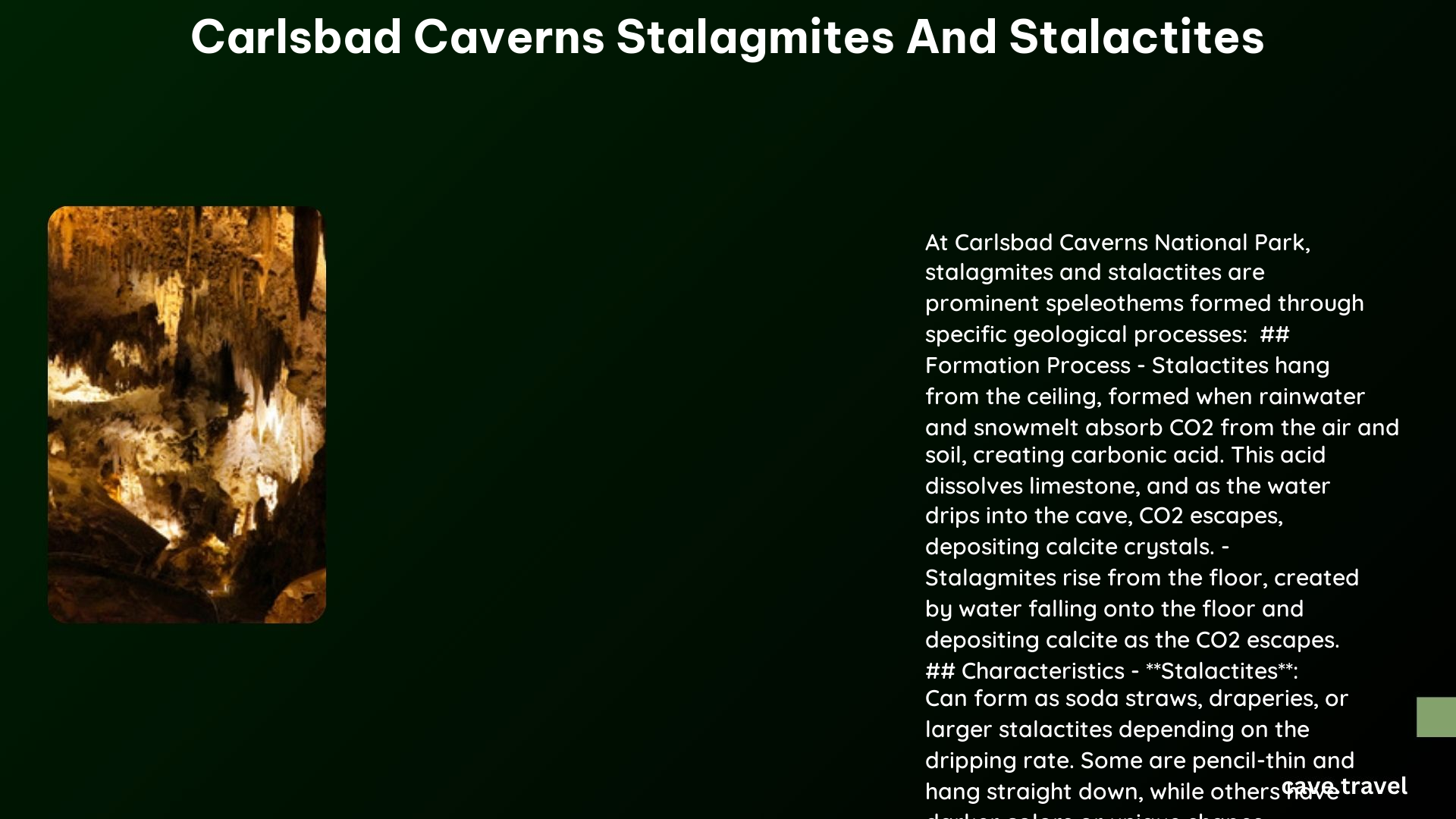Carlsbad Caverns, a natural wonder in New Mexico, is renowned for its spectacular stalagmites and stalactites. These limestone formations, created over millions of years, showcase nature’s artistry in underground chambers. The caverns’ unique geology, influenced by ancient seas and limestone dissolution, has produced an array of stunning speleothems. From towering columns to delicate soda straws, these formations offer visitors a glimpse into Earth’s geological history and the ongoing processes that shape our planet’s hidden landscapes.
What Are the Formation Processes of Stalagmites and Stalactites in Carlsbad Caverns?

The formation of stalagmites and stalactites in Carlsbad Caverns is a complex process involving the interaction of water, limestone, and carbon dioxide. Here’s a breakdown of the key steps:
- Water absorption of carbon dioxide:
- Rainwater absorbs CO2 from the atmosphere and soil
-
This creates a weak carbonic acid solution
-
Limestone dissolution:
- The acidic water seeps through limestone bedrock
-
It dissolves calcium carbonate from the rock
-
Cave chamber entry:
- Water enters cave chambers through cracks and pores
-
As it drips, CO2 is released, causing mineral precipitation
-
Formation growth:
- Stalactites form as minerals accumulate on the ceiling
- Stalagmites grow upward from the cave floor
- Over time, these formations can meet to create columns
The rate of formation is incredibly slow, often taking thousands of years for significant growth to occur.
How Do Growth Rates Vary in Carlsbad Caverns’ Formations?

Growth rates of stalagmites and stalactites in Carlsbad Caverns can vary significantly based on several factors:
- Water flow rate
- Mineral concentration in the water
- Cave temperature and humidity
- CO2 levels in the cave atmosphere
Here’s a table showing estimated growth rates for different formations:
| Formation Type | Estimated Growth Rate |
|---|---|
| Soda Straws | 0.1-3 mm per year |
| Stalactites | 0.1-10 cm per century |
| Stalagmites | 0.1-60 cm per century |
| Columns | Highly variable |
It’s important to note that these rates are averages, and actual growth can be much slower or faster depending on local conditions within the cave system.
What Unique Geological Features Contribute to Carlsbad Caverns’ Formations?
Carlsbad Caverns’ distinctive geological features play a crucial role in the development of its stalagmites and stalactites:
- Capitan Reef Complex:
- The caverns are part of an ancient marine fossil reef
-
This provides the limestone necessary for speleothem formation
-
Sulfuric acid dissolution:
- Unlike many caves formed by carbonic acid, Carlsbad was primarily shaped by sulfuric acid
-
This created larger, more dramatic chambers
-
Permian Basin location:
- The cave’s position in this geological region influences its mineral composition
-
It contributes to the unique coloration of some formations
-
Arid climate:
- The dry environment above ground affects water flow into the cave
- This impacts the rate and pattern of speleothem growth
These factors combine to create the diverse and spectacular formations found throughout the caverns.
What Are the Most Notable Stalagmites and Stalactites in Carlsbad Caverns?
Carlsbad Caverns boasts several remarkable stalagmites and stalactites that have become iconic features of the cave system:
- Giant Dome:
- A massive column in the Big Room
- Formed by the joining of a stalactite and stalagmite
-
Stands approximately 62 feet tall
-
Rock of Ages:
- A large stalagmite in the Big Room
-
Known for its impressive size and shape
-
Witch’s Finger:
- A thin, elongated stalactite
-
Notable for its unusual curved shape
-
Crystal Spring Dome:
- An active formation still growing today
-
Fed by water seeping through the cave ceiling
-
Bottomless Pit:
- While not a stalagmite or stalactite, this 140-foot deep chasm is surrounded by impressive formations
These formations showcase the diversity and scale of speleothems found within Carlsbad Caverns.
How Does Mineral Composition Affect the Appearance of Carlsbad’s Formations?
The mineral composition of Carlsbad Caverns’ stalagmites and stalactites significantly influences their appearance:
- Calcite:
- The primary mineral in most formations
-
Creates white or translucent appearances
-
Iron oxides:
- Produce reddish or brownish hues
-
Often seen in draperies and flowstones
-
Manganese oxides:
- Result in black or dark brown coloration
-
Can create striking patterns on formation surfaces
-
Gypsum:
- Forms delicate needle-like crystals
- Creates sparkly, frost-like appearances on some formations
The interplay of these minerals, along with variations in water flow and deposition rates, results in the diverse and colorful array of formations throughout the caverns.
What Conservation Efforts Protect Carlsbad Caverns’ Stalagmites and Stalactites?
Preserving the delicate formations in Carlsbad Caverns is a top priority for park management. Several conservation measures are in place:
- Visitor restrictions:
- Designated pathways to prevent direct contact with formations
-
Limited tour group sizes to reduce environmental impact
-
Climate control:
- Monitoring and maintaining cave temperature and humidity
-
Airlock entrances to minimize outside air influence
-
Lighting management:
- Use of LED lights to reduce heat and algae growth
-
Limited lighting hours to protect the cave environment
-
Scientific research:
- Ongoing studies to understand formation processes
-
Monitoring of growth rates and environmental changes
-
Education programs:
- Informing visitors about the importance of preservation
- Training staff in best practices for cave conservation
These efforts aim to ensure that future generations can continue to marvel at these natural wonders.
How Can Visitors Best Experience Carlsbad Caverns’ Stalagmites and Stalactites?
To fully appreciate the stalagmites and stalactites of Carlsbad Caverns, visitors should:
- Take guided tours:
- Expert rangers provide in-depth information about formations
-
Access to areas not available on self-guided tours
-
Use the audio guide:
- Offers detailed explanations of key formations
-
Available for self-guided tours of the Big Room
-
Attend ranger programs:
- Learn about cave geology and formation processes
-
Often include interactive elements for better understanding
-
Visit during off-peak hours:
- Early morning or late afternoon for fewer crowds
-
Allows for a more immersive experience
-
Bring appropriate gear:
- Comfortable walking shoes for cave trails
-
Light jacket (cave temperature is consistently around 56°F)
-
Respect cave rules:
- No touching formations
- Stay on designated paths
- No flash photography
By following these guidelines, visitors can have a memorable and educational experience while helping to preserve the caverns for future generations.
References:
1. National Park Service – Carlsbad Caverns
2. Carlsbad Caverns Trading Company – Cavern Formation
3. NPS History – Carlsbad Caverns
